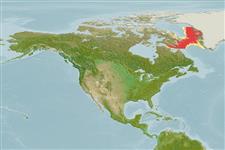Common names from other countries
Environment: milieu / climate zone / depth range / distribution range
Ökologie
seewasser bathydemersal; tiefenbereich 39 - 1200 m (Ref. 117245), usually 71 - ? m (Ref. 117245). Deep-water; 0°C - 5°C (Ref. 35388); 74°N - 61°N, 72°W - 45°W (Ref. 117245)
Arctic to Northwest Atlantic: Canada to Greenland.
Size / Gewicht / Alter
Maturity: Lm ? range ? - ? cm
Max length : 52.0 cm TL Männchen/unbestimmt; (Ref. 4695); common length : 27.5 cm TL Männchen/unbestimmt; (Ref. 4695)
Dorsal fin without depression, front end with 0-3 black - brown spots. Lateral line runs near the anal fin (Ref. 35388).
Lives at temperature of 0-5°C. Off Greenland it measures 50 cm and off Scandinavia rarely over 25-30 cm (Ref. 35388). Benthic (Ref. 58426). Feeds mostly on endobenthic prey, with shrimps and euphausiids becoming the more prominent prey as the size increases (Ref. 13532). Prefers warmer waters (Ref. 13534). Large eggs of 6 mm diameter are deposited on the sea floor.
Life cycle and mating behavior
Geschlechtsreife | Fortpflanzung | Ablaichen | Eier | Fecundity | Larven
Anderson, M.E., 1994. Systematics and osteology of the Zoarcidae (Teleostei: Perciformes). Ichthyol. Bull. J.L.B. Smith Inst. Ichthyol. 60:120 p. (Ref. 11954)
IUCN Rote Liste Status (Ref. 130435)
CITES (Ref. 128078)
Not Evaluated
Bedrohung für Menschen
Harmless
Nutzung durch Menschen
Fischereien: kleinfischerei
Mehr Information
NamenSynonymeMetabolismusRäuberÖkotoxikologieFortpflanzungGeschlechtsreifeAblaichenFecundityEierEientwicklung
ReferenzenAquakulturAquakultur ProfilZuchtlinienGenetikElectrophoresesVererbbarkeitKrankheitenVerarbeitungMass conversion
PartnerBilderStamps, Coins Misc.LauteCiguateraGeschwindigkeitSchwimmstilKiemenoberflächeOtolithsGehirngrößeSehfähigkeit
Tools
Zusatzinformationen
Download XML
Internet Quellen
Estimates based on models
Preferred temperature (Ref.
115969): 1.4 - 5.6, mean 3.2 (based on 263 cells).
Phylogenetic diversity index (Ref.
82804): PD
50 = 0.5000 [Uniqueness, from 0.5 = low to 2.0 = high].
Bayesian length-weight: a=0.00219 (0.00137 - 0.00348), b=3.18 (3.04 - 3.32), in cm Total Length, based on LWR estimates for this species & (Sub)family-body (Ref.
93245).
Trophic level (Ref.
69278): 3.4 ±0.42 se; based on food items.
Widerstandsfähigkeit (Ref.
120179): sehr niedrig, Verdopplung der Population dauert mehr als 14 Jahre. (Preliminary K or Fecundity.).
Fishing Vulnerability (Ref.
59153): Moderate vulnerability (41 of 100).
